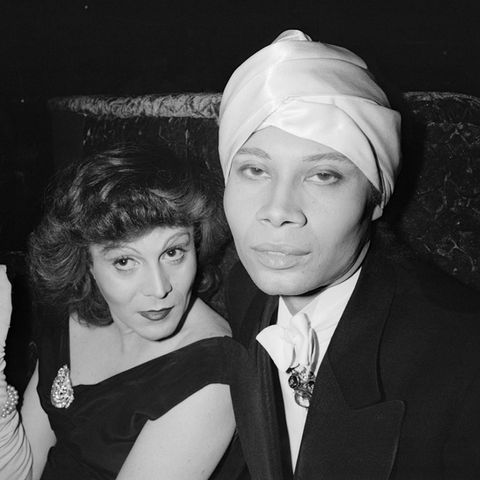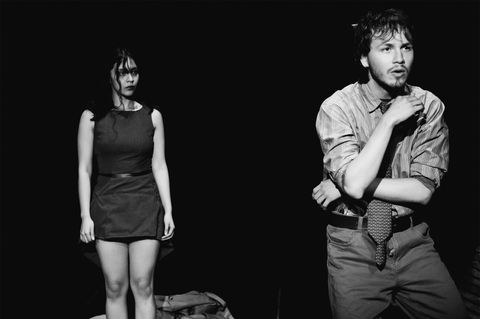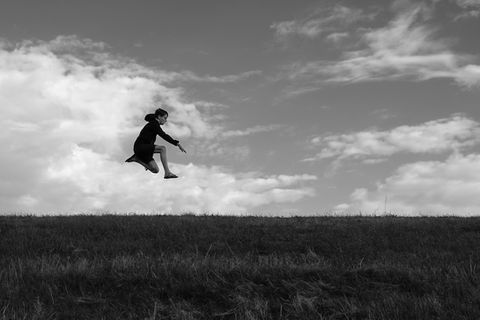
NEW YORK PARADISE LOST: BUSHWICK ERA DISCO
June 28, 2021
INTERVIEW
PHOTOGRAPHY Meryl Meisler
INTERVIEW Melanie Meggs
It was a time of vivid nightlife, with its electric beats and the infectious laughter of those out to enjoy themselves. But during the day, it was a very different story. Bushwick in the 1980s was a neighbourhood marred by crime, addiction and the ravages of AIDS. But one woman had the courage and vision to document both sides of this story; to tell the tale of a city torn apart by a tumultuous time in history. New York street photographer Meryl Meisler's exhibition, New York PARADISE LOST: Bushwick Era Disco, chronicles the hedonistic nightlife scene of the late 1970s and pairs it with poignant images of those who lived through it – all through the gaze of her lens.
Meryl’s remarkable journey began in 1975 when she returned to her hometown of New York City with a camera in one hand and a dream in the other. Inspired by photographers such as Diane Arbus and Jacques Henri Lartigue, as well as her own father and grandfather, Meryl studied with Lisette Model, and began to capture her city on film. By day she worked as a freelance illustrator, but by night she frequented and photographed the iconic discos of New York City. As a 1978 C.E.T.A. (Comprehensive Employment and Training Act) Artist grant recipient, Meryl created a portfolio of photographs that explored her Jewish identity for the American Jewish Congress. Then she embarked on a three-decade career as an New York City Public School Art Teacher, while still managing to capture moments of beauty in what some considered an ugly city.
Now, after retiring from teaching in 2010, Meryl has released a collection of her previously unseen work – love letters captured through her lens – which were kept secret for decades. In this interview we will be speaking to Meryl about her first steps into photography, her time as a school teacher, her inspirations, and working and living during this challenging period of Covid-19. For behind every photograph is a story, and Meryl’s journey is one that needs to be heard.

“I got my first camera, 'The Adventurer' as a 7th birthday present from my parents Sunny and Jack. Dad, a printer by trade, was a terrific photographer. Grandpa Murray Meisler, a machinist, always had a camera and light meter on him. It didn't matter if you ever saw the photographs, the action of photography (like singing to oneself) was essential and satisfying in itself. As a 7-year-old, I photographed my family, friends, and trips. Those have been my life subjects.
When I took my first photography class in 1973, I didn't have a flash while enrolled at the University of Wisconsin-Madison. I walked around the streets of Madison, taking my first rolls of B/W film. When I moved to NYC in 1975, my camera came with me everywhere. If I saw something interesting on the street on my way to where I was going, I'd pause to photograph it. In retrospect, I didn't go to photograph. I photographed where I was going.”
IN CONVERSATION WITH MERYL MEISLER
THE PICTORIAL LIST: Meryl, it is such a great honor to have you featured. How did you get into the disco scene in New York in the 1970s, which must have been quite a contrast to your daytime job as a school teacher?
MERYL MEISLER: In 1977, I was taking a class about making a photo book at The New School. The instructor, Bob Adelman, told me about the upcoming “COYOTE Hookers Masquerade Ball” on Valentine’s Day at the Copacabana. I put on my Girl Scout uniform, brought a camera and flash, and talked my way into the wild party. It was my first big extravaganza disco event. I loved it. On a bus returning from Mardi Gras in LA, in 1977, I met Judi Jupiter. We became friends and hit all the hottest clubs together. In 1979, I became an NYC Public School Art Teacher. That cut my nightlife back a lot. I never went out on school nights, but there were still weekends.
TPL: Tell us a bit about Bushwick, what is it's background, it's demographics then and now, how has it changed from the time you took those photos?
MM: Bushwick is a neighborhood in the northern part of Brooklyn, bordering Queens. It was a Dutch Settlement purchased from the Canarsie Indians in 1638. For a short introduction to Bushwick’s history and current community, I suggest starting with the Community Board 4 (representing Bushwick) on the NYC.gov site.
When I arrived in December 1981 to be a teacher in Bushwick, it was a tough, difficult time - socially and economically in NYC and this neighborhood. There were many burnt-out buildings and garbage-strewn lots. Flash forward four decades, the buildings are occupied, lots of new construction and most of the lots are cleaned up. Bushwick is a hub of new music, art, fashion, literature, nightlife, and creative thinking. However, many bemoan the gentrification of neighborhoods like Bushwick. There is nostalgia and sorrow for what is lost in the process of change.
TPL: How do you find your inspiration to keep photographing?
MM: Photography is something I enjoy doing and am challenged by at the same time. It lifts my spirits and makes me feel more attuned to everyday experiences of life. In my opinion, it is vital to find a community of supportive people who have similar passions or interests. For example, I’ve been a long-time member of Professional Women Photographers. Artists communities give one another advice, share, and make opportunities to exhibit, provide critical feedback and become role models to keep on and going forth, whether or not you get timely recognition.
TPL: With the pandemic over the past year and a half, it has been tough on many artists. How have you been feeling through this time, both personally and as a photographer. Do you have any advice as an artist to get through these tough times?
MM: Health and well-being come first. If you are going through temporary or long-term difficulties, seek professional help. I am fortunate to be in a long-term relationship and was not isolated. Emotionally, it was very challenging. To help maintain a sense of safety and balance during quarantine, I set up a routine with zoom - therapy, movement class, spiritual community, and social activism. Working on this book and exhibits, and building a darkroom, helped me stay physical and mentally healthy and grounded.
TPL: What photographers made the most impact on you at the beginning of your photography journey?
MM: As a child, I looked up to my dad's photographs of family events before and during my lifetime. The 1972 Diane Arbus retrospective at MoMA captivated and inspired me. The following year I enrolled in an introduction to photography class while in grad school at the University of Wisconsin at Madison. When professor Cavalliere Ketchum showed the playful childhood photographs on the streets of Paris by Jacques Henri Lartigue, I decided to photograph my friends and family on my visits home to Long Island. Walker Evans encouraged me to capture subway riders. Margaret Bourke White made me more conscientious of juxtapositions. Brassaï inspired me to capture the nightlife I was living. Roman Vishniac heightened my awareness that life as we know it can be taken away, cease to exist. Lisette Model's snapshot aesthetic and encouragement when I studied with her kept me photographing from the heart and gut. Helen Levitt whispered in my ear as I documented children playing on the street.
Photography is something I enjoy doing and am challenged by at the same time. It lifts my spirits and makes me feel more attuned to everyday experiences of life.

TPL: Where has been your most favourite place to photograph?
MM: New York City is my “magic city.” Every time I set foot in NYC, its energy recharges me. The variety of people, food, arts, architecture, old and new, young and forever young, wise souls and inquiring minds, longtime residents and recent arrivals, history in the making, bright sunlight, the mysteries of the night - they all enchant me.
TPL: What happens when you go out with your camera? Do people respond positively to you, or do you sometimes get negative reactions? If yes, how do you handle it?
MM: Most of my street photographs are not candid. Then and now, I usually ask the subjects verbally or with non-verbal cues if I may take their photograph. People usually gave their permission. Pre-covid, in the heights of the pandemic, and now - if a person replies no, I respect their wish not to be photographed. It is no big deal. I am very selective about who and what I photograph and often tell the person what sparked my interest.
TPL: When you take pictures, do you usually have a concept in mind of what you want to photograph, or do you let the images just 'come to you', or is it both?
MM: Unless on an assignment, I don’t have a preconceived concept of what I will photograph. Of course, if I am going to a specific event, for example, a drag performance, I want to photograph the performers. I photograph things that look so familiar; they might seem like a Norman Rockwell painting reenactment. I photograph things I’ve never seen before. I’m drawn to the ordinary and extraordinary.
TPL: Does the equipment you use help you in achieving your vision in your photography? What camera do you use? Do you have a preferred lens/focal length?
MM: In the 1970s, I used a Norita Graflex - 120 SLR medium format, Vivitar flash, and TriX 400 film. If the Norita Graflex was in repair, I used a Minolta SRT101 loaded with color slide film (preferably Kodachrome 64). When I started teaching in Bushwick in the 1980s, it felt risky to carry an expensive camera. So, I bought an early point-and-shoot pocket camera (I think it was a Canon Sure Shot) and used color slide 35mm film. I have used a variety of cameras over the decades - analog and digital. When the Norita Graflex became “arthritic”- no longer worked in the cold area, I bought a Pentax 6x7. It’s a bit too heavy for me to carry around. Two years ago, I found someone who could repair the Norita - so I am back to using it and found another used one as a backup. I prefer a wide-angle lens, the equivalent of a 35mm lens in 35mm photography. The medium format wide angle equivalent is 55mm. Currently, my “carry around” is a Fujifilm X100. Ironically, with the Fuji autofocus - too many of my images are out of focus. I prefer a split image focusing system.
TPL: What are some of your goals as an artist or photographer? Where do you hope to see yourself in five years?
MM: My immediate goals, after the exhibits, release and events related to New York PARADISE LOST Bushwick Era Disco are: Work on a monograph that EYESHOT will publish. It will be an overview of my street photography from 1973-2021. In October 2021, I'm scheduled for my first solo exhibit in Europe at Fotogalerie Friedrichshain in Berlin. Another book of the 1970s and 1980s never released photographs of hot spots across the USA that I've had on the backburner urges to be realised. There are thirty-six years of my insider's point of view photographing NYC schools that yearn to be edited, made into a book, and exhibited. In addition to continuing to dig through my vast archives, I plan to create a new series of self-portraits and continue carrying my camera along to familiar places and new adventures. From time to time, I get messages from people who find themselves, their family, or friends in my 1980s Bushwick photos. I've toyed with the idea of photographing those people now long enough. I might begin doing it. Where would I hope to see myself in five years? A solo museum exhibit would be divine. Most importantly, I hope to be alive and well and going forth.
TPL: When I am not out photographing, I (like to)…
MM: I like to spend quality time with my life partner Patricia, close family, and friends. I enjoy dining at home or out, catching up with life, laughing and making new memories together. Live musical theatre is my entertainment of choice - I look forward to Broadway & Off-Broadway reopening and traveling more. I can’t carry a tune but like belting it out with the crowd at a piano bar.

Meryl Meisler is an inspiration to street photographers everywhere. She has devoted her life to her craft with passion and candor, making her an undeniable force in the world of photography. We are grateful for her time and for the opportunity to learn from her. To get even more inspired, visit Meryl's website and follow her on Instagram. Let us all learn from her and take her enthusiasm for street photography as our own.

















































